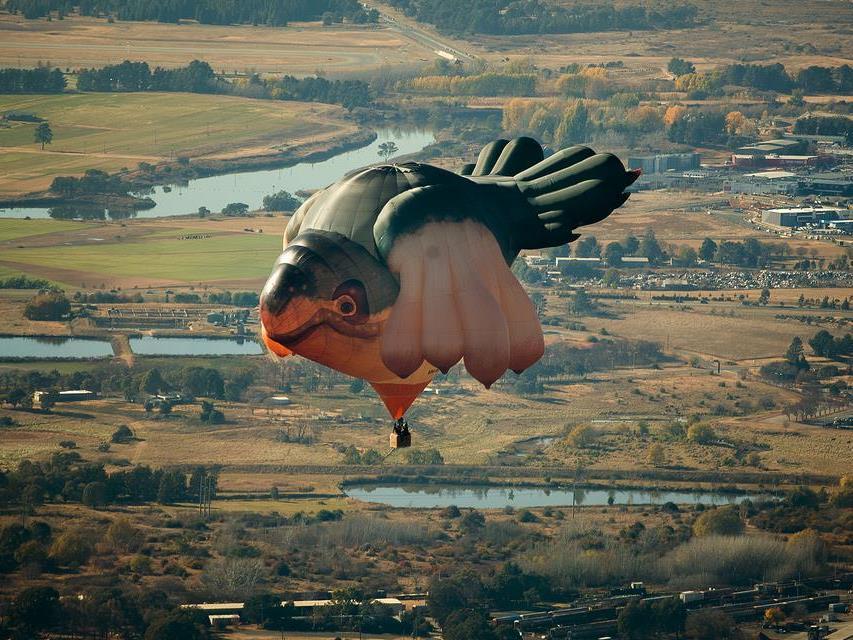What better way to mark the centenary of our nation’s capital than a giant floating Skywhale with teats, hovering past as bewildered public servants looked up from their coffee? Well that’s exactly what happened when Skywhale launched as part of Canberra’s Centenary celebrations. Patricia Piccinini’s work is known for embracing the strange; for twisting our concept of familiar into that of the alien and apart from its sheer size and the fact that it was in the sky, this piece was no different.
‘When I was approached for this commission, I made a very conscious decision to approach it as a sculpture rather than as a special shape balloon. I felt it had to fit in with the rest of my practice, both aesthetically and conceptually,’ wrote Piccinini in Six Observations about The Skywhale. She designed the piece based on the planned nature of the capital, which has been deliberately constructed around its landscape. ‘In its ideal it aspires to blend the natural and the artificial, and this really fits with the ideas in my work. So it seemed that some sort of colossal, airborne creature would be perfect.’Some people loved the work, some thought it a waste of money and some thought it was an inappropriate way to celebrate Canberra’s centenary. Conservative columnist Tim Blair called the work ‘The perfect symbol of our capital city – a bloated, gaseous, multi-breasted monster feeding those who dwell in its poisonous shadow while leeching off the rest of us.’
But no one can deny it was talked about. According to figures released by Centenary Canberra Skywhale received 5,200 mentions on twitter, 35,000+ uses of the Twitter hashtag and 1,010 uses of the hashtag on Instagram.

2. Paul Yore vs Justin Bieber
Melbourne artist Paul Yore’s exhibition Like Mike at the Linden Centre for Contemporary Art earlier this year was shut down and Yore was charged with producing child pornography. The incident sparked claims of censorship and had people wondering if this was a case of a right wing campaign against arts funding. People even drew comparisons between Yore and photographer Bill Henson, who faced a similar outcry a few years back.
The work that caused the furore was a collage of an underage Justin Bieber with a fake phallus. The resulting charges also saw his work pulled from Sydney Contemporary later in the year due to fears it would contravene the law.
His case is due to appear before the courts early next year. Whatever the outcome for Yore, 2013 was certainly a year of uncertainty and unwanted artistic attention for the artist.
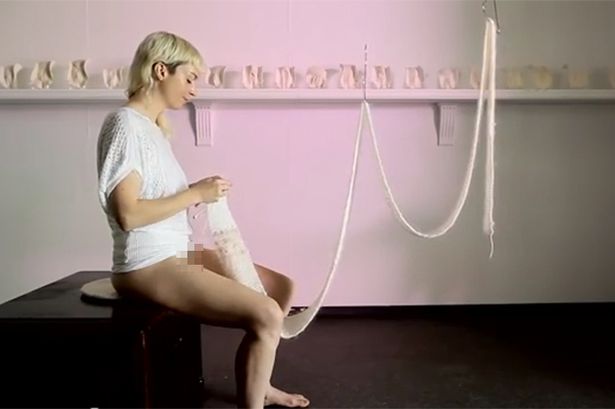
Melbourne artist Casey Jenkins’ performance piece Casting Off My Womb sees the artist is spending 28 days knitting with wool stored in her vagina as a form of ‘craftivism’. She won’t pause for her menstrual cycle either. American website Gawker got hold of the story, as did the Huffington Post in the UK and international publications such as The Daily Mirror. Those familiar with feminist art won’t find anything to groundbreaking here, but as Gawker’s Adam Weinstein writes, ‘Is it cutting-edge art in 2013? Perhaps not. But it’s still jarring. And perhaps its power lies in the fact that the same feminist themes and visuals that shocked us in the ’60s and ’70s still shock us today.’
The symbols in Jenkins’ piece, such as the 28 day menstrual cycle, knitting as a symbol of a ‘woman’s place’ and her embrace of the taboo all make for interesting discussion whether you like the work or not.
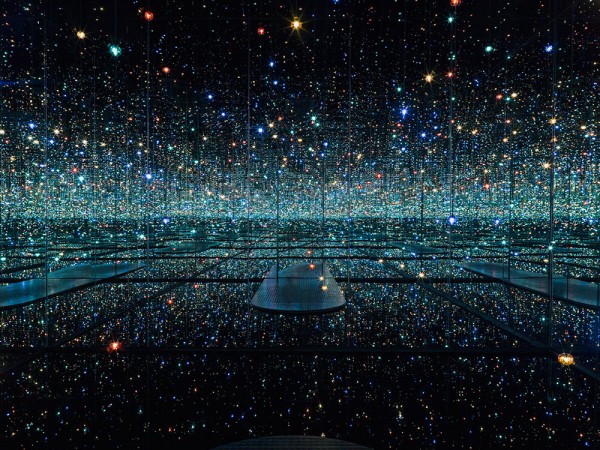
The exhibition I Who Have Arrived In Heaven is an Instagrammer’s dream, and with wait times of up to four hours to actually get in and see it, the payoff would want to be well worth it. Japanese artist Yayoi Kusama has used her token dots in this large scale exhibition which spans three consecutive locations on West 19th Street in New York. There are 27 new large scale paintings and a video installation, but what has really got people talking is the two mirrored infinity rooms, one which has been created especially for this exhibition.
Kusuma has work that spans across some of the most important movements in art to take place in the last 50 years, most notably minimalism and pop art and as an artist she has received a lot of attention over the years. The centrepiece of this exhibition proves she’s still got it. Hundreds of multi-coloured LED lights are suspended from the ceiling at different hights, flickering and producing the effect of infinity as they reflect throughout the mirror panelled room with a shallow reflecting pool.
Just take a look for yourself to see how people are experiencing it.

It came. You saw it. It conquered. And while critics may not have loved it, it was the talk of Melbourne. Most of the criticism faced by the musical was the lack of show stopping songs and character development, but none could refute the skill of the 10 puppeteers who, under the direction of Peter Wilson, created a gargantuan feat in on-stage animatronics.
The production picked up five Helpmann Awards for Best Costume Design, Best Scenic Design, Best Lighting Design, Best Sound Design and Outstanding Theatrical Achievement and is now planning its next move. It is hoped it will be able to make similar waves overseas.
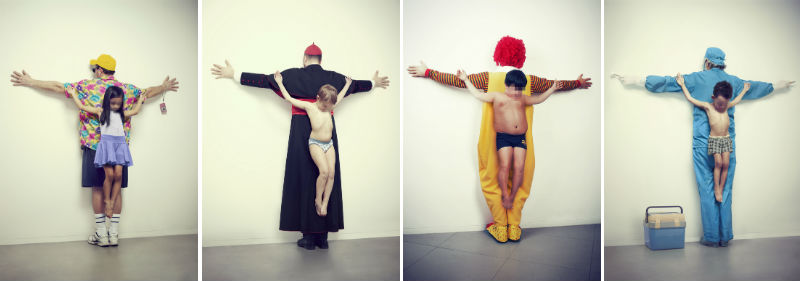
Cuban artist Erik Ravelo has used two elements that are almost guaranteed controversy when it comes to art: children and religion. In his series he has used images of children sacrificed on the ‘cross’ of the ways in which we damage them – war, food, religion, violence – it’s all covered.
The children are pixilated to preserve their identities, but Facebook still had an issue with them and tried to take them down. But the artist and his friends continued to repost them. ‘My intention is not to offend anyone but make people think about a problem,’ Ravelo said.
‘All the news about the civil war in Syria involving many children casualties, and particularly in this case the fact that I live in Italy strongly determined the direction of the series Los Intocables,’ he said.
Some will find these images too confronting, but others will see them a powerful statement about the tragic fate that belies some of our most vulnerable.
7. Banksy’s Sirens of the Lambs
Banksy is probably the most famous contemporary artist working today and when he talks people listen. While this work featured no spray cans, it was still in typical Banksy style in that it was on the street and made a statement.
The artist decked out a slaughter house style truck full of stuffed animals who baahed and bleated as they passed shocked onlookers as it drove through Brooklyn. The statement wasn’t subtle, and it sure caught people’s attention. The work was part of Banksy’s New York residency, which in itself was one of the most talked about art events of the year.

If you can look at this photo without wincing then we applaud you. Performance artist Pyotr Pavlensky decided to make a statement by nailing his testicles to Red Square. Pavlensky is already known to those following the censorship of artists in Russia. In 2012 he sewed his mouth shut to protest the imprisonment of the band Pussy Riot. He also wrapped himself in barbed wire in front of the City Parliament of St. Petersburg earlier this year.
‘A naked artist, looking at his balls nailed to the Kremlin pavement, is a metaphor for the apathy, political indifference, and fatalism of contemporary Russian society,’ Pavlensky wrote in a statement.
It was a brave thing to do in Russia, and not just for the pain factor. Pavlensky, after receiving medical assistance, was arrested and has since been charged. He could face up to five years in prison on charges of hooliganism.

Some puritans may still not consider television programming as ‘art’ but to them we say ‘get used to it’. Television has come a long way and while there are still some garishly coloured morning programs out there ruining it for everyone, some of the best actors, scriptwriters and other artists in the world are now working in television. Both the Breaking Bad finale and the Game of Thrones episode ‘The Red Wedding’ saw popularity and quality converge.
They are both also indicative of a time when a television audience can participate. These are active viewers. Reaction videos were created, people wrote in depth blog posts about their feelings, and office workers all over the world, even though they might not have been aware of it, analysed the craft of storytelling – and that can only be a good thing.
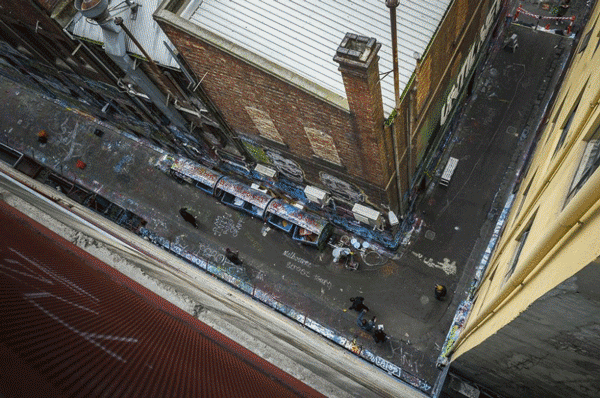
Image via Vandalog
Melbourne’s most famous street art precinct, Hosier Lane received a couple of makeovers this year. While the space is constantly evolving as more and more artists make their contributions, these two were quite dramatic. The first and most talked about was Adrian Doyle’s blueing of Rutledge lane. The second was Melbourne Now’s All Your Walls complete repainting of the area.
‘By using Empty-Nursery Blue to cover Hosier Lane, I am symbolically ‘coating’ my present with my past, it is reminder to me and anyone who is living, that you are a product of your former experiences, and you should be reminded of them as you work your way through your present and into your future,’ wrote Doyle.
‘By doing this, I am claiming that a colour in its pure form can be street art or graffiti. This is a great conceptual link from fine art to street art, a link that is often lacking in the Melbourne Street Art scene. By bridging this gap, I hope to expose more people not only to Street Art, but also to the importance of art in general.’
